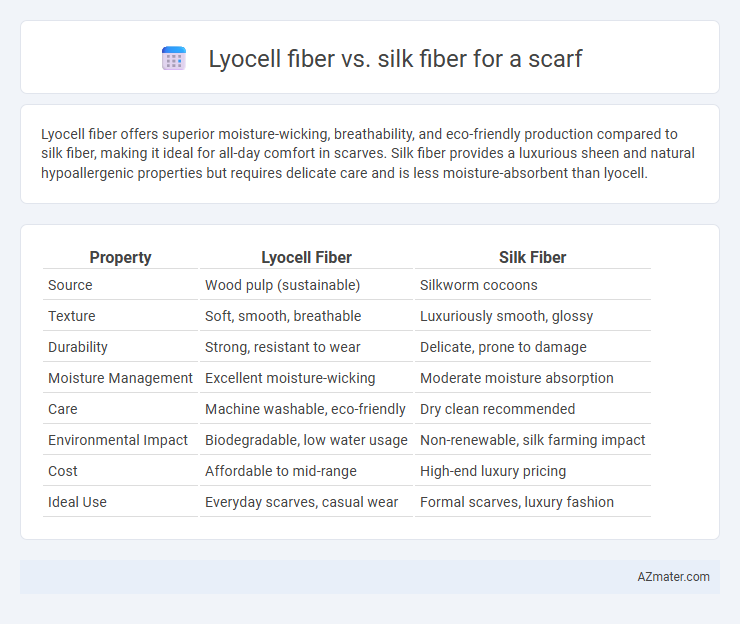Lyocell fiber offers superior moisture-wicking, breathability, and eco-friendly production compared to silk fiber, making it ideal for all-day comfort in scarves. Silk fiber provides a luxurious sheen and natural hypoallergenic properties but requires delicate care and is less moisture-absorbent than lyocell.
Table of Comparison
| Property | Lyocell Fiber | Silk Fiber |
|---|---|---|
| Source | Wood pulp (sustainable) | Silkworm cocoons |
| Texture | Soft, smooth, breathable | Luxuriously smooth, glossy |
| Durability | Strong, resistant to wear | Delicate, prone to damage |
| Moisture Management | Excellent moisture-wicking | Moderate moisture absorption |
| Care | Machine washable, eco-friendly | Dry clean recommended |
| Environmental Impact | Biodegradable, low water usage | Non-renewable, silk farming impact |
| Cost | Affordable to mid-range | High-end luxury pricing |
| Ideal Use | Everyday scarves, casual wear | Formal scarves, luxury fashion |
Introduction to Lyocell and Silk Fibers
Lyocell fiber, derived from sustainably sourced wood pulp, offers a soft, breathable, and moisture-wicking fabric ideal for scarves, combining eco-friendliness with durability. Silk fiber, produced by silkworms, is renowned for its luxurious texture, natural sheen, and excellent thermal regulation, making it a classic choice for high-end scarves. Both fibers provide distinct advantages in comfort and style, with lyocell emphasizing sustainability and silk highlighting elegance.
Origin and Production Processes
Lyocell fiber is derived from sustainably harvested wood pulp, primarily from eucalyptus trees, and manufactured through a closed-loop solvent spinning process that recycles water and solvents, minimizing environmental impact. Silk fiber originates from silkworm cocoons and is produced through a labor-intensive process of reeling and weaving, involving boiling the cocoons to extract continuous filaments. Both fibers offer distinct origins--plant-based versus animal-derived--and production methods, influencing their sustainability profiles and material characteristics for scarves.
Environmental Impact and Sustainability
Lyocell fiber for scarves offers a more sustainable environmental profile compared to silk, as it is derived from fast-growing eucalyptus trees using a closed-loop process that recycles water and solvents, minimizing waste and pollution. Silk production involves silkworm cultivation, which requires significant land, water, and energy inputs and often results in the ethical concern of killing silkworms during harvesting. The biodegradability and lower carbon footprint of Lyocell make it an eco-friendly choice for scarves, aligning with sustainable fashion practices aimed at reducing resource consumption and environmental degradation.
Texture and Feel on Skin
Lyocell fiber offers a smooth, soft texture with a breathable and moisture-wicking feel, making it ideal for sensitive skin. Silk fiber provides a luxurious, silky-smooth surface with a naturally cool and lightweight touch that feels elegant against the skin. Both fibers excel in softness, but lyocell is often preferred for its hypoallergenic and eco-friendly properties, while silk is prized for its natural sheen and opulent feel.
Breathability and Moisture Management
Lyocell fiber offers superior breathability and moisture management compared to silk, making it an excellent choice for scarves in warm or active conditions. Its hydrophilic properties allow Lyocell to absorb and release moisture efficiently, keeping skin dry and comfortable throughout the day. Silk, while lightweight and smooth, tends to retain moisture and lacks the same level of airflow, which can result in less effective temperature regulation.
Durability and Longevity
Lyocell fiber offers superior durability and resistance to wear compared to delicate silk fibers, making it ideal for everyday scarf use. Silk, while luxurious and soft, is prone to abrasion and requires gentle care to maintain its integrity over time. Scarves made from lyocell maintain their strength and shape longer, ensuring lasting performance through frequent wear and washing.
Hypoallergenic Properties
Lyocell fiber is renowned for its hypoallergenic properties due to its breathability, moisture-wicking abilities, and resistance to dust mites and allergens, making it ideal for sensitive skin in scarves. Silk fiber, while naturally smooth and less irritating, can sometimes cause allergic reactions in individuals sensitive to sericin proteins. For hypoallergenic scarves, Lyocell offers a more consistently gentle option, especially for those prone to allergies or skin sensitivities.
Color Vibrancy and Dye Affinity
Lyocell fiber exhibits superior dye affinity due to its cellulose-based structure, resulting in vibrant, long-lasting colors that resist fading on scarves. Silk fiber, composed of protein fibers, absorbs dyes deeply, producing rich, luxurious color with a natural sheen that enhances vibrancy. For scarves, Lyocell offers better color retention in bright hues, while silk provides exceptional brilliance and depth in darker tones.
Price Comparison and Value
Lyocell fiber scarves generally cost less than silk fiber scarves due to more affordable raw materials and sustainable production methods. Silk scarves typically command higher prices because of their natural luxury appeal, smooth texture, and traditional craftsmanship. Considering durability, moisture-wicking properties, and cost, lyocell offers excellent value for eco-conscious buyers seeking affordability without compromising softness.
Styling and Care Tips for Lyocell and Silk Scarves
Lyocell scarves offer a smooth, matte finish that complements both casual and sophisticated outfits, while silk scarves provide a luxurious sheen ideal for elegant and formal looks. Lyocell requires gentle machine washing in cold water with mild detergent and air drying to maintain its softness and shape, whereas silk scarves benefit from hand washing with a delicate soap and drying flat away from direct sunlight to preserve their natural luster. Both fibers respond well to low-heat steaming to remove wrinkles, but silk is more prone to water spots and should be handled with extra care during styling.

Infographic: Lyocell fiber vs Silk fiber for Scarf
 azmater.com
azmater.com